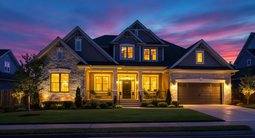TL;DR
Day to dusk—also called virtual twilight—is smart listing photo editing that turns a bright daytime exterior into a moody, evening scene. It makes real estate photography feel premium, boosts curb appeal, and often increases clicks and inquiries. If you can’t schedule a sunset shoot, twilight conversion and careful listing photo editing can deliver the same emotional impact—fast.
Why Twilight Photos Matter in Real Estate Today

Twilight lighting creates a serene, welcoming atmosphere buyers connect with emotionally.
Twilight photos tap into the way buyers browse today: fast, visual, and emotional—and day to dusk editing puts that power in your hands. In the first 100 words, here’s the intent: buyers click more on a twilight photo, and agents use real estate photography and listing photo editing to make the exterior feel premium with virtual twilight. If you’re wondering why twilight real estate photos get more clicks, it’s simple: the scene looks cinematic, calm, and move‑in ready. Rule of thumb: your lead image should convey “evening welcome” at a glance, with warm windows, tidy landscaping, and a balanced sky (alt‑text: front elevation at blue hour with porch lights aglow and a smooth indigo‑to‑rose sky).
How Day‑to‑Dusk Editing Works

Day-to-dusk editing pairs cool skies with warm window light to create appealing twilight visuals.
Twilight editing simulates blue hour by pairing a cooler sky with warm window light so buyers instantly read the scene as evening. At its core, day‑to‑dusk is a controlled transformation. Editors replace a flat daytime sky with a realistic gradient—indigo near zenith, warmer near horizon—then harmonize color temperature so exterior bulbs and interior windows glow naturally. In real estate photography, that means shifting cool ambient light outside while keeping interior light between roughly 2700–3000K for believable warmth. Next comes exposure balance and contrast. Highlights are tamed so siding doesn’t glare; shadows are opened just enough to show texture in roofing, brick, and landscaping. If the lawn is patchy, light retouching can even tones without inventing features. HDR blending is often used sparingly to preserve window detail without creating halos. Lighting cues sell the scene. Editors “turn on” porch, garage, and landscape lights, add subtle reflections to window glass, and ensure the direction of light and shadow matches the sky. Minor cleanups—dust spots, lens flare, crooked verticals—finish the frame so the listing feels crafted, not edited (alt‑text: two‑story craftsman with warm mullioned windows, clean vertical lines, and soft garden uplights).
Anecdote
A coastal agent tested two MLS hero images: a standard noon shot and a virtual twilight with path lights and window warmth. The twilight version got more saves and booked the weekend with back‑to‑back tours.
Why Twilight Photos Sell Better

Twilight photos evoke comfort and privacy, making listings more compelling to buyers.
Twilight photos work because they compress a lot of buyer psychology into one frame: comfort, privacy, and aspiration that daylight rarely conveys. Buyers respond to contrast. Against a serene sky, warm windows signal life inside; the brain reads it as “home” and lingers. That pause increases click‑through, which in turn lifts online listing performance. A day to dusk hero image also elevates curb appeal by hiding harsh midday shadows, flattening distractions, and guiding the eye to architecture, pathways, and entry lighting. Twilight feels premium. Luxury magazines, hotel sites, and architectural portfolios lean on evening exteriors because the mood promises quiet and quality. In crowded portals, a strong virtual twilight hero can be the difference between a skim and a showing—one reason agents search for the best day‑to‑dusk editing for property listings. Real stories / micro‑anecdotes: - The photographer with a weather problem: Rain chased Mia off a scheduled sunset shoot. She delivered a clean daytime frame instead; a virtual twilight conversion gave the bungalow a cobalt sky, warm windows, and pool sparkle. The seller’s text after the weekend: “We doubled showings—keep that look for the brochure.” - The hesitant seller: Victor worried a twilight photo might look “too staged.” His agent ran an A/B test on the MLS hero image. The twilight photo got more clicks and longer on‑page time, and Victor’s open house filled up. He now asks for twilight first. - The exterior that finally told a story: A lake house showed as a grey mass at noon. With virtual twilight, the shoreline path, dock lights, and reflections stitched a narrative buyers could imagine living in. The agent said buyers “felt the weekend” from one image.
Common Day‑to‑Dusk Mistakes (and How to Avoid Them)

Avoid editing errors by ensuring realistic light behavior and consistent color tones in twilight photos.
Realism is the anchor of effective virtual twilight editing; if light doesn’t behave, buyers sense it instantly. - Heavy‑handed skies: Overly dramatic, magenta‑only sunsets scream “filter.” Choose a sky with a natural gradient and subtle cloud texture; keep saturation just under your interior warmth. - Inconsistent light direction: If the sky glows from the right, landscape lights shouldn’t cast long shadows to the left. Align glow and shadows to one direction or keep them soft. - Cold windows, warm sky: A frequent tell. Keep interior light warmer than the sky so windows read like late evening, not midday fluorescents. - Blown fixtures and haloing: Porch lights clipped to pure white look fake. Pull back exposure, add a soft 1–2 foot halo, and retain fixture detail. - MLS compliance misses: Don’t remove power lines or alter permanent features without disclosure. Listing photo editing should enhance, not mislead buyers. Quick fix rule: when in doubt, reduce saturation, align verticals, and check window color temperature at the end (alt‑text: colonial facade with corrected verticals and gentle, amber window glow).
Pro Tips from Real Estate Photographers (+ Tools & Resources)

Pro tips and consistent editing tools help photographers perfect virtual twilight listings for better results.
Consistency across the set is what sells the illusion; match sky tone, window warmth, and contrast from the hero image through secondary angles. - Start with the gradient: Pick a sky plate with believable directionality—darker zenith, warmer horizon—so eaves and soffits get a soft kiss of color. Avoid hard bands. - Balance Kelvin values: Keep interiors around 2700–3000K and the sky cooler; blend with selective white balance so trim stays neutral, not cyan. - Paint the windows last: Add a soft, interior glow and a hint of reflection. A faint vertical falloff at the sash makes it read as real glass, not a sticker. - Respect foliage luminance: Greens go muddy at night. Lift shadows subtly so trees don’t look like cut‑outs, and dial back clarity to keep edges natural. - Look for secondary cues: A subtle pool shimmer, driveway specular highlights, or a porch pendant reflection in a sidelight makes the twilight photo feel photographed, not fabricated. Tools & resources (neutral options for different workflows): - AI conversions for speed: For AI day‑to‑dusk or virtual twilight, explore ReimagineHome. It’s helpful when you need fast iterations or want to test multiple skies before committing. - Manual editing and full‑service visuals: For manual twilight editing & full‑service photo enhancement, consider Styldod. This path suits agents who want hands‑on retouching, MLS‑ready outputs, and a consistent look across a full photo set. Tip to remember: always compare the hero image on mobile first—most buyers will meet your listing on a phone.
Visualization Scenario
Imagine the hero image as buyers’ first glance on a phone: indigo sky, porch sconces softly radiating, and the front walk catching just enough sheen to guide the eye to the door (alt‑text: blue hour facade with warm window glow and lit pathway).
Day‑to‑Dusk and Virtual Twilight: FAQs
Q: How do I convert a day photo to dusk for real estate without hiring a photographer? A: Use virtual twilight or day to dusk editing: replace the sky, warm interior windows, turn on exterior lights, and balance exposure. Many agents start with an AI pass, then refine with manual listing photo editing for MLS. Q: Why do twilight real estate photos get more clicks? A: A twilight photo offers high contrast—cool sky, warm windows—that feels premium and welcoming, so buyers linger. That emotional pause often boosts online listing performance and show‑request rates. Q: What’s the best day‑to‑dusk editing for property listings if I’m short on time? A: Fast AI tools can produce solid virtual twilight bases, while full‑service editors polish realism and compliance. Test both to find the best day‑to‑dusk editing for property listings in your market. Q: How can I enhance real estate photos for MLS without over‑editing? A: Prioritize straight verticals, natural sky gradients, accurate colors, and honest cleanup (dust, minor distractions). The goal of real estate photography is enhancement, not altering permanent features. Q: What’s the best way to do virtual twilight editing for real estate agents managing multiple listings? A: Build a style guide—preferred sky tones, window warmth, and contrast—and apply it consistently. Batch your day to dusk workflow so every listing’s hero image looks cohesive across your brand.
The Last Light Is Often the First Impression
Presentation isn’t vanity; it’s translation. In an online‑first market, a thoughtful day to dusk lead image translates a property’s exterior story into mood and meaning. The craft is subtle—sky, glow, and restraint—but the effect is immediate: buyers pause, picture themselves arriving at dusk, and feel invited to step inside.
.svg)

.svg)














.png)